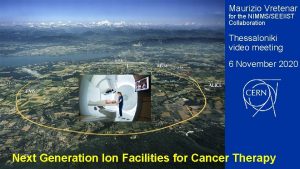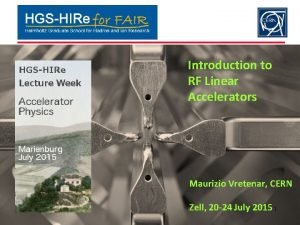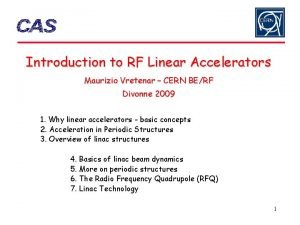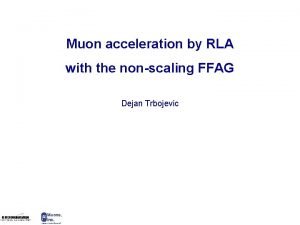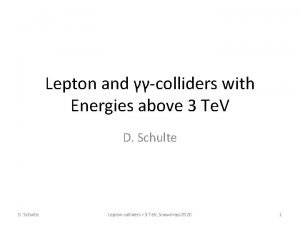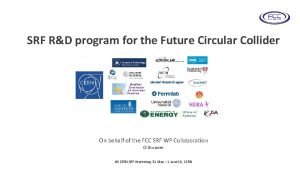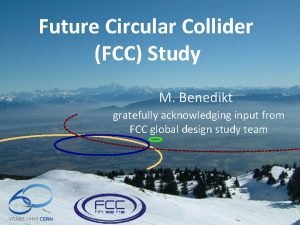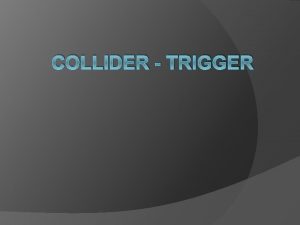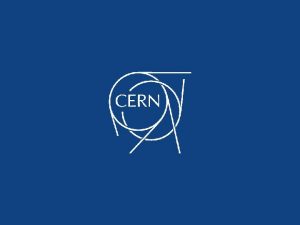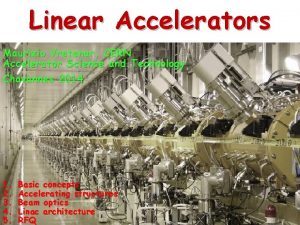Muon collider EU cofunding considerations Maurizio Vretenar CERN







- Slides: 7

Muon collider: EU cofunding considerations Maurizio Vretenar, CERN Coordinator of the ARIES Project ARIES is co-funded by the European Commission Grant Agreement number 730871

EU Roadmap to new Research Infrastructures Generic R&D Design Study ESFRI Roadmap Preparatory Phase Implementation The European Union has a well-defined roadmap for selection and implementation of new Research Infrastructures of pan-European (or world-wide) interest. The European Commission via the Research Infrastructures branch of its Framework Programmes (Horizon 2020 and the coming Horizon Europe) supports collaborative projects going along this line, via a number of Calls for proposals. • Generic R&D is supported by Integrating Activites, Innovation Projects or other instruments (like ARIES=Accelerator Research and Innovation for European Science and Society). • Design Studies are meant to produce the Conceptual Design Report of a new fullyfledged user facility. • ESFRI (European Strategy Forum on Research Infrastructures) selects projects in terms of maturity (technical-political-financial) and scientific impact, for further support via Preparatory Phase projects towards final implementation. 2

The muon collider at the start of the road… Generic R&D Design Study ESFRI Roadmap Preparatory Phase Implementation Today, the muon collider is here ! The goal of ARIES is to explore and promote innovative particle accelerator designs and technologies. Via its WP 5 it has contributed to relaunching the studies on the Muon Collider in Europe. To take over at the end of the 4 -year ARIES in April 2021, the proposal for a new “Innovation Pilot” I. FAST (Innovation Fostering in Accelerator Science and Technology) has been just submitted. The outcome of the evaluation should be known in October. I. FAST includes the “Muon Colliders Strategy Network” MUST (INFN, CERN, CEA, CNRS, KIT, PSI, UKRI, coordinated by N. Pastrone) to support Muon Collider design and plans for R&D. MUST covers the period 2021 -2025. 3

Next step, a Design Study? • A Design Study Project can get up to 3 M€ for 3 years, for a collaboration of 10 -20 partners (laboratories, universities, and possibly industry). It can include both design and prototyping. • Budget is not too high, added value is in formalising a collaboration, in showing EU support to attract additional funding, and in preparing for the further steps. • A Design Study (DS) will produce a Conceptual Design Report based on a specific site (or on few alternative sites), with concepts and plans for R&D and construction, and an estimated budget for construction and operation. • Design Study calls are usually issued every 2 years. Preparation of the Proposal (80 pages) takes a minimum of 6 months. • There is usually strong competition for Design Studies. Proposals come from every field of science, including social sciences and humanities. At the last call (November 2019) the success rate was only 18% (10 project approved out of 60 submitted, only 1 for physics selected). • Examples: at the moment, for accelerators we are completing 2 DS (Eu. Praxia for a compact plasma-based FEL and Euro. Cir. Col for FCC), we are running ESSnu. SB for a neutrino superbeam at ESS, and has been just approved FCC-IS, for FCC-ee. 4

The right moment for a Design Study • The study needs to reach some maturity and concentrate on one (or few) “feasible” options. • Potential showstoppers should have been addressed, but R&D can still be needed. • Support from a hosting laboratory is very important. TIMING: • The last DS call went out in 2019, and the next ones could be reasonably expected for 2021 and 2023 – with project start in 2022 and 2024. • However, we are now in the transition phase between Horizon 2020 and Horizon Europe (whose budget has not yet been adopted because of internal discussion and of the virus emergency, and it is expected to be strongly reduced because of Brexit and economy relaunching measures). Some delay in the calls might be expected, as an increase in the competition. 5

Other options • Specific R&D items could be funded by other instruments. • I. FAST would have been the right tool for R&D, but the proposal was just submitted and the successor to I. FAST will only start in 2025. • However, I. FAST will issue in 2022 an internal call for “Developments” with an EC contribution of 100 -200 k€ for a 2 -year acivity. Interesting option, should involve some industrial partner. • Other instruments may come out after lobbying the European Commission in the preparation of the new Horizon Europe programme (2021 -2027). 6

Next actions and conclusion • The new Strategy Update document is a central instrument for lobbying the European Commission for more support to accelerator R&D in the next Horizon Europe programme. • Coordinated actions in this sense are already in preparation, via the CERN Management and at the level of the Research Infrastructure Unit by the TIARA Committee. TIARA is preparing a Position Document for accelerators in Horizon Europe. • New instruments and opportunities might come out, and we will immediately inform the Muon Collider community of Calls and deadlines. The MUST Network in I. FAST is the best tool to follow this evolution and to prepare for further actions. A EC-supported Design Study is an ideal instrument for the Muon Collider community to produce a preliminary Conceptual Design Report in the time windows 2022 -2025 or 2024 -2027. 7
